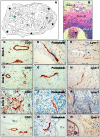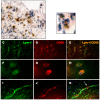Lymphatic vascularisation and involvement of Lyve-1+ macrophages in the human onchocerca nodule
- PMID: 20011036
- PMCID: PMC2784295
- DOI: 10.1371/journal.pone.0008234
Lymphatic vascularisation and involvement of Lyve-1+ macrophages in the human onchocerca nodule
Abstract
Onchocerciasis, caused by the filarial nematode Onchocerca volvulus, is a parasitic disease leading to debilitating skin disease and blindness, with major economic and social consequences. The pathology of onchocerciasis is principally considered to be a consequence of long-standing host inflammatory responses. In onchocerciasis a subcutaneous nodule is formed around the female worms, the core of which is a dense infiltrate of inflammatory cells in which microfilariae are released. It has been established that the formation of nodules is associated with angiogenesis. In this study, we show using specific markers of endothelium (CD31) and lymphatic endothelial cells (Lyve-1, Podoplanin) that not only angiogenesis but also lymphangiogenesis occurs within the nodule. 7% of the microfilariae could be found within the lymphatics, but none within blood vessels in these nodules, suggesting a possible route of migration for the larvae. The neovascularisation was associated with a particular pattern of angio/lymphangiogenic factors in nodules of onchocerciasis patients, characterized by the expression of CXCL12, CXCR4, VEGF-C, Angiopoietin-1 and Angiopoietin-2. Interestingly, a proportion of macrophages were found to be positive for Lyve-1 and some were integrated into the endothelium of the lymphatic vessels, revealing their plasticity in the nodular micro-environment. These results indicate that lymphatic as well as blood vascularization is induced around O. volvulus worms, either by the parasite itself, e.g. by the release of angiogenic and lymphangiogenic factors, or by consecutive host immune responses.
Conflict of interest statement
Figures






References
-
- Beveridge I, Kummerow EL, Wilkinson P. Observations on Onchocerca gibsoni and nodule development in naturally-infected cattle in Australia. Tropenmed Parasitol. 1980;31:75–81. - PubMed
-
- Bain O, Bussieras J, Amegee E. [Further description of two African bovine's Onchocerca (author's transl)]. Ann Parasitol Hum Comp. 1976;51:461–471. - PubMed
-
- Collins RC, Lujan R, Figueroa H, Campbell CC. Early formation of the nodule in Guatemalan onchocerciasis. Am J Trop Med Hyg. 1982;31:267–269. - PubMed
-
- Brattig NW. Pathogenesis and host responses in human onchocerciasis: impact of Onchocerca filariae and Wolbachia endobacteria. Microbes Infect. 2004;6:113–128. - PubMed
Publication types
MeSH terms
Substances
LinkOut - more resources
Full Text Sources
Miscellaneous

